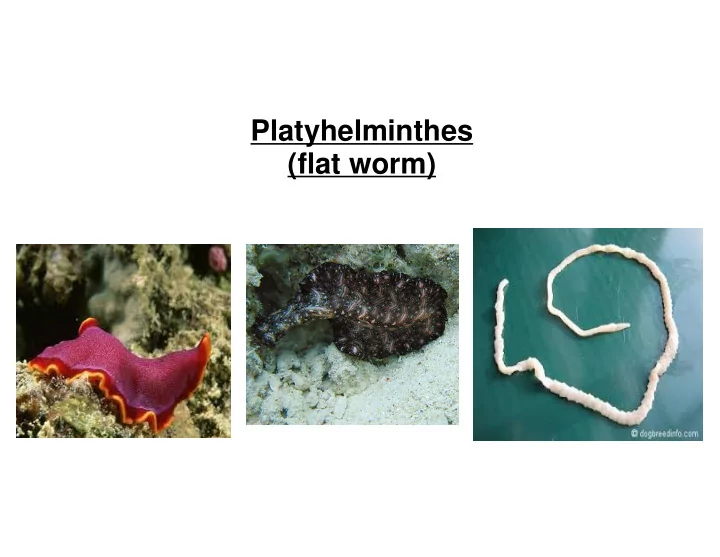

Platyhelminthes (flat worm)
Platyhelminthes ● They are a phylum of relatively simple bilateral, unsegmented, soft-bodied invertebrates.
Platyhelminthes Breathing: ● All Platyhelminthes breathe using their entire body. Being flat, oxygen diffuses quickly across the skin and to all parts of the body, so they don't need a blood circulatory or respiratory system.
Platyhelminthes ● There are more than 20,000 species of Platyhelminthes. 3 main types of Platyhelminthes: ● Turbellaria ● Trematoda (flukes). ● Cestoda (Tapeworms)
Turbellaria ● free-swimming mostly freshwater flatworms ● They are mostly nocturnal and live in shaded humid locations. ● There are about 4,500 species, which range from 24 inches to 0.039 inches.
Turbellaria ● Reproduction: -they reproduce mostly sexually, and sometimes asexually. -All turbellarians are hermaphrodites.
Turbellaria Feeding: ● Most are carnivores, eating tiny aquatic invertebrates such as rotifers, small crustaceans and other worms
Turbellaria ● Moving: ● Many Turbellarians move by moving their muscles or cilia in an undulating motion ● sliding over mucus, helps them get form leaf to leaf ● Swim http://www.youtube.com/watch? v=zCH37KI_R_E#t=47
Turbellaria ● Sensing: ● Many species of Turbellaria have light sensitive spots on their front end (these are called ocelli), and some have small flaps sticking out of the side of their heads.
Trematoda ● They are parasitic flatworms. ● Most trematodes have a complex life cycle with at least two hosts. -The primary host, where the flukes sexually reproduce, is a vertebrate. -The intermediate host, which is the agent of dispersal, is usually a snail. ● http://www.youtube.com/watch? v=r7okJ6wHYLA
Trematoda Reproduction: ● Practically the entire interior is occupied by the reproductive system; the organism is capable of producing huge numbers of offspring. ● They are hermaphrodites and reproduce both sexually and asexually
Trematoda ● Movement: ● They have tail-like structures, cilia, for moving and finding molluscs
Trematoda Eating: ● The mouth is located at the forward end of the animal, and opens into a muscular, pumping pharynx ● Adult flukes eat blood cells, mucus, and body cells
Cestoda (tape worms) ● Humans are subject to parasitism by several species of tapeworms if they eat underprepared meat such as pork , beef, and fish. Or if they live in, or eat food prepared in, conditions of poor hygiene. ●
What is the range of size for tapeworms?
They range from 0.5 in. to 100 ft.
Cestoda ● Feeding: Each of the independent segments is able to absorb the digested food from the host's gut, by diffusion and active transport. Their waste products are released back into the gut the same way.
Cestoda ● Reproduction: ● They are hermaphrodites. ● They do not reproduce asexually, only sexually.
Cestoda Moving: ● Tapeworms can move around by crawling or squirming. They usually come from feces and as they move around they release eggs that will later hatch into larvae or be eaten by fleas
Recommend
More recommend